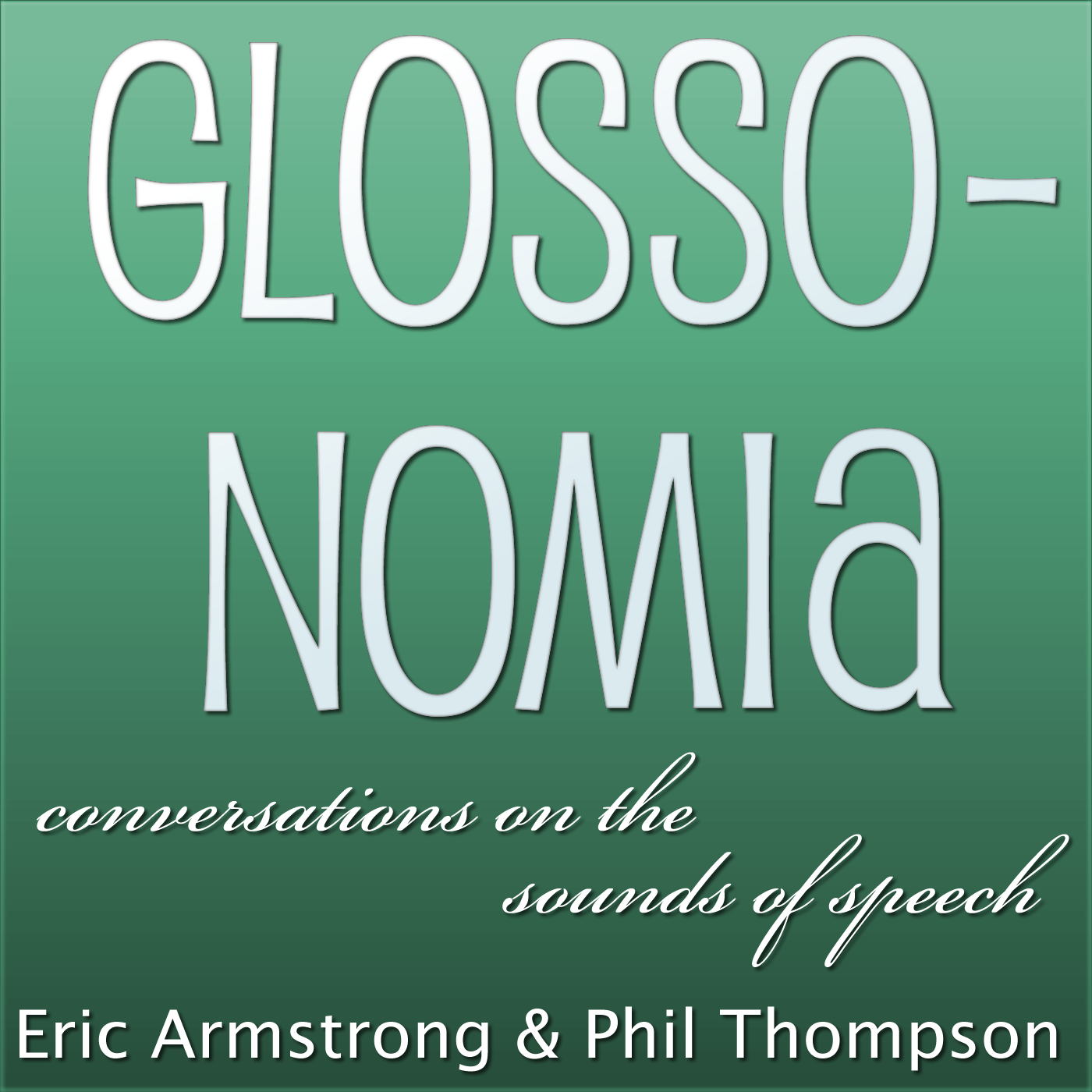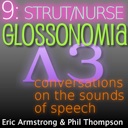Episode 9: strut & nurse [ ]

b' Word! Shut. Up. This week, Phil and Eric explore the mid-central vowel space, including [\\u0258, \\u0275, \\u0259, \\u025c, \\u025e, \\u0250] and even discuss the (completely theoretical at this point) new symbol [a]. Yes, we do explore the strut and nurse lexical sets, too.
Word! Shut. Up. This week, Phil and Eric explore the mid-central vowel space, including [\\u0258, \\u0275, \\u0259, \\u025c, \\u025e, \\u0250] and even discuss the (completely theoretical at this point) new symbol [a]. Yes, we do explore the strut and nurse lexical sets, too.
Show Notes:
Phonemes are \\u201cthe idea of a sound\\u201d, the building blocks we have in our minds that help us construct words. One can say they are the smallest segment of sound employed to form meaningful contrasts between words. Phones, on the other hand, is the physical and acoustic realization of that phoneme, \\u201cwhat comes out your mouth.\\u201d Different accents can have different phones to represent the same phoneme.
Allophones are variants of a phoneme, based on the context where the phoneme occurs. So there are different allophones of /t/ initially or following /s/: initial /t/ is aspirated [t\\u02b0], while /t/ following /s/ is unaspirated [st=].
Examples of unstressed vs. stressed mid-vowels: about vs. love, probably [\\u0259\\u02c8ba\\u028at] vs. [l\\u028cv], depending on your accent.
Vowel quality: \\u201cThe articulatory features that distinguish different vowel sounds are said to determine the vowel\'s quality. Daniel Jones developed the cardinal vowel system to describe vowels in terms of the common features height (vertical dimension), backness (horizontal dimension) and roundedness (lip position). There are however still more possible features of vowel quality, such as the velum position (nasality), type of vocal fold vibration (phonation), and tongue root position.\\u201d\\u2014Wikipedia
Daniel Jones\\u2019 map of the Cardinal Vowels, compared to his realization of his RP vowels, marked in red.
The official IPA Vowel Chart, showing the central vowels down the centre line. The newly recommended symbol, small cap A would be placed in the middle between [a] and [\\u0251].
Phil\\u2019s journey of the central vowels:
\\u0259 \\u2192 \\u0268
\\u0258 \\u2192 \\u0264
Eric\\u2019s close-mid exploration (Front-central-back): e \\u2192 \\u0258 \\u2192 \\u0264
\\u0259 \\u2192 \\u025c
Phil\\u2019s open-mid exploration (Front-central-back): \\u025b \\u2192 \\u025c \\u2192 \\u028c
Phil\\u2019s unrounding of the open-mid vowel (staying back): \\u0254 \\u2192 \\u028c
Phil\\u2019s comparison of the open-mid unrounded vowel with and without tongue root retraction: \\u028c \\u2192 \\u028c\\u0319 \\u2192\\u028c \\u2192\\u028c\\u0319
[ Phil and Eric then get confused, or at least Eric confuses matters because he thinks Phil is discussing /\\u0250/, while Phil means to discuss /a/. ]
Eric thinks that a (aka \\u201ctype A\\u201d for Eric, \\u201cprint A\\u201d for Phil) looks like a typewriter. The top part of it, the hook, looks like the carriage return, while the bowl of the glyph looks like the body of the character. Phil described the hook as like a partridge\\u2019s crest. ( I think he was think of the bird, not Danny...)
He thinks \\u0250 (aka \\u201cturned type/print A\\u201d) looks like an italic e with a little hook or crest on the upper left.
\\u0259 \\u2192 \\u025c \\u2192 \\u0250
Eric thinks of how to find \\u0250 as a backed version of \\xe6
\\xe6 \\u2192 \\u0250
Another variable: lip rounding.
Unrounded vs. Rounded
(barred i) \\u0268 - \\u0289 (barred u)
(reversed e) \\u0258 - \\u0275 (Brigitte barred-O)
(schwa) \\u0259 - \\u0259\\u0339 (schwa with lip rounding)
\\u025c - \\u025e (\\u201cthe sideways butt\\u201d)
(turned type A) \\u0250 - \\u0250\\u0339 (turned type A with lip rounding)
Discussion of the proposed vowel [a], as an open central vowel.
Phil: \\u201cThe tension between the phonetic reality and the phonemic reality is a very fraught one.\\u201d
From Wikipedia: In quantum mechanics, the Heisenberg uncertainty principle states that certain pairs of physical properties, like position and momentum, cannot both be known to arbitrary precision. That is, the more precisely one property is known, the less precisely the other can be known.
comma and strut
n.b. We\\u2019re focusing on the non-rhotic (r-less) version of the lexical sets at this point.
nurse and strut
\\u201cWinnie ther Pooh\\u201d vs. \\u201cWinnie thuh Pooh\\u201d, i.e. probably perceived as a nurse vowel rather than as a strut vowel, as Phil might imagine \\u201cthe\\u201d as when in stressed form.
strut Spelling conventions:
cup, cut, suck, much, snuff, fuss, rush,
rub, bud, jug, budge, buzz,
hum, run, lung, dull,
pulse, bulge, punch, lump, hunt, trunk,
butter, study, punish, number, mustn\'t, Guthrie,\\u2026;
done, come, love, mother, stomach,
monk, tongue, onion, money, front,\\u2026;
touch, enough, young, double, southern, country,\\u2026;
blood, flood.
\\u2014J.C. Wells\\u2019 Lexical Sets from Accents of English, vol. 1, Ch. 2
\\u201coo\\u201d and \\u201cou\\u201d would have been more /u/ or /\\u028a/-like, similar to what we get in the Midlands of the UK today.
Phil calls the symbol \\u028c, turned-v, while Eric calls it hut.
nurse Spelling conventions:
Typical Spellings: -ur, -or, -ir, -er, -earC
usurp, hurt, lurk, church, turf, purse
curb, curd, urge, curve, furze,
turn, curl, spur, occurred,
burnt, burst, murder, further,
shirt, irk, birch, birth, bird, dirge
firm, girl, fir, stirred, first, circus, virtue,\\u2026;
myrrh, myrtle, Byrne;
twerp, assert, jerk, perch, serf, berth, terse,
verb, erg, emerge, nerve,
term, stern, deter, err,\' preferred
certain, person, immersion, emergency, kernel
Earp, earth, dearth, hearse, rehearse, search
heard1 earn, yearn, earl, pearl,
rehearsal, early, earnest;
wort, work, worth, worse, word, worm, whorl,
worst, Worthing, worthy, whortleberry;
scourge, adjourn, courteous,2 journal, journalist, journey;
attorney, colonel, liqueur, masseur, connoisseur.
\\u2014J.C. Wells\\u2019 Lexical Sets from Accents of English, vol. 1, Ch. 2
Discussion of [\\u028c] for strut and other options.
This chart is something Eric whipped up for a class showing possible ranges where his (Canadian) students might expect to find their own realization of the vowels. You can see how the [\\u028c] takes up more \\u201cturf\\u201d on the chart than any other symbol, hence it is the largest state in the contiguous united states of the Glossonomia.
Phil\\u2019s joke re Oklahoma didn\\u2019t elicit much laughter from Eric because his knowledge of US geography sucks. This picture did draw forth a smile as he finally got what Phil was talking about...
Then we go on to listen to a sample collected by Peter Trudgill, comparing putt and bird, which are good examples of strut and nurse.
Phil keeps referring to the Phonetic Symbol Guide by William A. Ladusaw and Geoffrey K. Pullum. He also mentioned the famed phoneticians Daniel Jones and Henry Sweet at other points in the show.
Eric whips out his copy of Speak with Distinction and lists off information about how Edith Skinner described /\\u025c / as higher than both schwa and /\\u028c /.
Eric and Phil discuss the cognitive dissonance that arises from students rejecting the IPA when it isn\'t neat and easy. It\'s a good thing when it happens with students, figuring stuff out in class; it\'s not so much good when working with clients on a show!
Variations/Realizations in Various Accents:
strut: Phil takes us through a few variations from [st\\u0279\\u028at st\\u0279\\u0252t st\\u0279\\u0259t st\\u0279\\u0258t st\\u0279at]
Phil discusses Phonology & Orthoepy by Albert Salisbury, and how he guided pronunciations for the strut and nurse sets (scans at right taken from Google Books).
We then go on to talk about other variations of the nurse set, to talk about the New York and Louisiana sound of [\\u0252\\u026a \\u028c\\u026a].
Eric talks about nurse in African Englishes trading phones with dress lexical set.
Phil mentions that nurse keeps its rhoticity in "otherwise completely rhotic" accents, such as many Southern US accents, NYC and Boston, and Eric brings up New England English, with its non-rhotic nurse vowel, a la Mayor Quimby.
Our email: glossonomia@gmail.com'